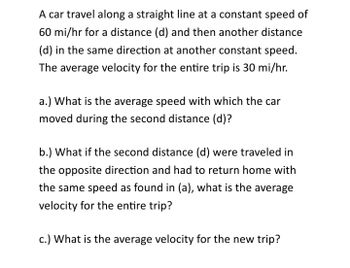
College Physics
11th Edition
ISBN: 9781305952300
Author: Raymond A. Serway, Chris Vuille
Publisher: Cengage Learning
expand_more
expand_more
format_list_bulleted
Concept explainers
Topic Video
Question
Solve the following problems and show you complete solutions. Write it on the paper and do not type it.

Transcribed Image Text:A car travel along a straight line at a constant speed of
60 mi/hr for a distance (d) and then another distance
(d) in the same direction at another constant speed.
The average velocity for the entire trip is 30 mi/hr.
a.) What is the average speed with which the car
moved during the second distance (d)?
b.) What if the second distance (d) were traveled in
the opposite direction and had to return home with
the same speed as found in (a), what is the average
velocity for the entire trip?
c.) What is the average velocity for the new trip?
Expert Solution
This question has been solved!
Explore an expertly crafted, step-by-step solution for a thorough understanding of key concepts.
Step by stepSolved in 3 steps with 6 images

Knowledge Booster
Learn more about
Need a deep-dive on the concept behind this application? Look no further. Learn more about this topic, physics and related others by exploring similar questions and additional content below.Similar questions
- Determine the indices for the direction shown in the following cubic unit cell: X Answer: Z For negative indexes use in front of the number. Use the proper type of brackets and no spaces. Answer: NIL Determine the Miller indices for the plane shown in the following unit cell: NIH y WIT For negative indexes use in front of the number. Use the proper type of brackets and no spaces.arrow_forwardExplain the meaning of this in detail?: Curl of vector f = ▽ x vector Farrow_forwardI need help with last problem. I keep getting it wrong.arrow_forward
- Elec X sou X Q Abc x Suck X SF Assi X ta The X A block Cchegg.coC chegg.co chegg.co The pers chegg.co + C use11fl.theexpertta.com/Common/TakeTutorialAssignment.aspx# theExpertTA.com Student bowenj@patriots.cf.edu My Account Log Out EXPERT ta Assignment Status Click here for detailed view Class Management | Help Work, Energy and power Begin Date: 2/29/2024 12:01:00 AM -- Due Date: 3/12/2024 11:59:00 PM End Date: 3/12/2024 11:59:00 PM (8%) Problem 9: A block of mass m is initially at rest at the top of an inclined plane which has a height of 4.67 m and makes an angle of 0=24.3° with respect to the horizontal. After being released, it is observed to be traveling at v=0.49 m/s a distance d after the end of the inclined plane, as shown. The coefficient of kinetic friction between the block and the plane is μp = 0.1, and the coefficient of friction on the horizontal surface is μr = 0.2. h m d m Problem Status * 50% Part (a) What is the speed of the block, in meters per second, just after it…arrow_forwardShow your step by step solutions. 6. With a wooden ruler, you measure the length of a rectangular piece of sheet metal to be 16 mm. With micrometer calipers, you measure the width of the rectangle to be 5.98 mm. Consider 4 significant figures only. Determine: (a) the area of the rectangle; (b) the ratio of the rectangle's width to its length; (c) the perimeter of the rectangle;arrow_forwardI need help on this problem: In the following right triangle, side c = 25 m and angle theta = 53.13. Find each of the following. Express each answer to the correct number of significant figure and use scientific notation if needed.arrow_forward
- magnitude of resultant recture = 4, determine the angle between the resultant vector and a horizontal line. Show work with steps please!arrow_forwardNeeds Complete typed solution with 100 % accuracy.arrow_forwardPlease see the attatched question. For question B, it needs to be drawn on a graphing paper. Please show all work and steps and explain where applicable.arrow_forward
- A jet leaves palermo, sicily, whose latitute is 38 degrees N flying due west. Eventually it returns to palermo again. Assuming that the earth has a 3960-mile radius: a.) find the distance the jet travels b.)find the distance from palermo to the equator along the surface of the earth. SHOW WORK AND PICTURESarrow_forwardNeeds Complete solution with 100 % accuracy. Otherwise skip if you can't give complete solution for both of them.arrow_forwardPlease see attached, thank youarrow_forward
arrow_back_ios
SEE MORE QUESTIONS
arrow_forward_ios
Recommended textbooks for you
 College PhysicsPhysicsISBN:9781305952300Author:Raymond A. Serway, Chris VuillePublisher:Cengage Learning
College PhysicsPhysicsISBN:9781305952300Author:Raymond A. Serway, Chris VuillePublisher:Cengage Learning University Physics (14th Edition)PhysicsISBN:9780133969290Author:Hugh D. Young, Roger A. FreedmanPublisher:PEARSON
University Physics (14th Edition)PhysicsISBN:9780133969290Author:Hugh D. Young, Roger A. FreedmanPublisher:PEARSON Introduction To Quantum MechanicsPhysicsISBN:9781107189638Author:Griffiths, David J., Schroeter, Darrell F.Publisher:Cambridge University Press
Introduction To Quantum MechanicsPhysicsISBN:9781107189638Author:Griffiths, David J., Schroeter, Darrell F.Publisher:Cambridge University Press Physics for Scientists and EngineersPhysicsISBN:9781337553278Author:Raymond A. Serway, John W. JewettPublisher:Cengage Learning
Physics for Scientists and EngineersPhysicsISBN:9781337553278Author:Raymond A. Serway, John W. JewettPublisher:Cengage Learning Lecture- Tutorials for Introductory AstronomyPhysicsISBN:9780321820464Author:Edward E. Prather, Tim P. Slater, Jeff P. Adams, Gina BrissendenPublisher:Addison-Wesley
Lecture- Tutorials for Introductory AstronomyPhysicsISBN:9780321820464Author:Edward E. Prather, Tim P. Slater, Jeff P. Adams, Gina BrissendenPublisher:Addison-Wesley College Physics: A Strategic Approach (4th Editio...PhysicsISBN:9780134609034Author:Randall D. Knight (Professor Emeritus), Brian Jones, Stuart FieldPublisher:PEARSON
College Physics: A Strategic Approach (4th Editio...PhysicsISBN:9780134609034Author:Randall D. Knight (Professor Emeritus), Brian Jones, Stuart FieldPublisher:PEARSON

College Physics
Physics
ISBN:9781305952300
Author:Raymond A. Serway, Chris Vuille
Publisher:Cengage Learning

University Physics (14th Edition)
Physics
ISBN:9780133969290
Author:Hugh D. Young, Roger A. Freedman
Publisher:PEARSON

Introduction To Quantum Mechanics
Physics
ISBN:9781107189638
Author:Griffiths, David J., Schroeter, Darrell F.
Publisher:Cambridge University Press

Physics for Scientists and Engineers
Physics
ISBN:9781337553278
Author:Raymond A. Serway, John W. Jewett
Publisher:Cengage Learning

Lecture- Tutorials for Introductory Astronomy
Physics
ISBN:9780321820464
Author:Edward E. Prather, Tim P. Slater, Jeff P. Adams, Gina Brissenden
Publisher:Addison-Wesley

College Physics: A Strategic Approach (4th Editio...
Physics
ISBN:9780134609034
Author:Randall D. Knight (Professor Emeritus), Brian Jones, Stuart Field
Publisher:PEARSON